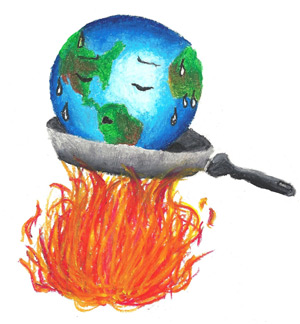Global warming: Doing my part to help the Earth
When I was in middle school, I didn’t feel there was much I could do to help the planet. I had learned about global warming and that it was caused by pollution from power plants and that it was melting polar ice caps. I cared about the polar bears that lived on the ice caps, but I felt it is was pointless for me to help. After all, what could I do about something so far away?
When I had learned to care for the environment in fifth grade, it seemed so simple, something I could do by recycling, using reusable bags and composting, which is using worms to create organic fertilizer from trash.
I suggested to my mother that we start a garden and begin composting. If you could see the tiny apartment we live in, you might understand her horror at the thought of live worms, dirt and rotting food invading it. She told me that maybe we would try composting later, which now I can see meant “not in my apartment.”
During middle school I decided that what I did made little difference, compared to factories with oozing smoke stacks or the millions of people who didn’t really care. I didn’t recycle and threw away plastic water bottles.
Then during my freshman year, a group called the Alliance for Climate Education (ACE) came to my school.
ACE explained that greenhouse gases like carbon dioxide and methane trap the sun’s heat close to the Earth. Too few greenhouse gases would send the planet into another ice age, but too many heat the planet a few degrees too warm for the plants and animals we need to survive. These gases are produced when people drive and burn coal and oil to produce electricity. Plants absorb carbon dioxide, however, people keep cutting forests down.
They told us that we could reduce greenhouse gases by doing the things I had learned in fifth grade, like composting and recycling.

Illustration by Cindy Kim, 16, Whitney HS (Cerritos)
They showed videos of other high school kids who had gotten solar panels at their schools and collected tons of recyclables. I felt like I could do the same things. Working with others I felt like I could make a difference.
That afternoon I joined the club ACE started at my school. We met weekly and brainstormed exciting ideas, like planting gardens in the school courtyards to sell fresh vegetables, clean-ups at local parks and installing solar panels on the school roof. The white board grew more and more crowded, but nothing was done beyond brainstorming; we didn’t even decide who would do what. After about a month, everyone lost interest when they realized nothing was happening.
Then, two years later, ACE came back. Their presentation reminded me that I could and should do something to help the Earth.
We had more realistic goals
The Thursday after the presentation, I went to my first meeting for the re-formed group. We were more realistic—we talked about recycling bins and turning off the lights for a few minutes each day. A lot of people say they care but they don’t do much. Everybody needs to help if we want to fix what’s wrong with the climate.
We used a device to test the watts that teachers’ computers and power point projectors use. We told teachers that they could do something as simple as turn off their lights and computers for five to 10 minutes during the a school day and save tons of energy. A computer uses 100-200 watts, depending on the model. The said they could definitely do that.
We also plan on buying recycling bins for the cafeteria and classrooms with grant money from ACE, as well as encouraging the staff and students to drink from reusable water bottles at school to earn key chains and pencils.
I feel like I’ve gotten more passionate about global warming. I recently chewed out a boy for littering and had a few trash-free lunches. I ate fruit instead of the school food that comes in cardboard boxes and plastic containers. I also began recycling at my house, which my mother was now happy to do because she saw I really wanted to do it.
It was difficult for me to get to this point, but I’ve learned that I can’t give up if I want to help the planet. Everything adds up, and something I do might just help someone else get inspired to help the environment too.
l
Other stories in our Spring 2012 environment package:
Electrifying the future. As electric cars become more popular, they’ll help clean the air.
The jobs of the future will be green jobs. You can make a living out of helping the environment. (March – April 2012)
 |
These stories were made possible by a grant from Edison International to write about the environment. |






1 Comment
[…] LA Youth […]